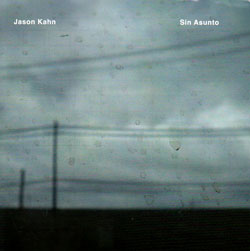
Along with peers such as Tomas Korber, Steinbrüchel and Günter Müller, Jason Kahn has crafted a unique, evolving precedent in the electroacoustic world. He proceeds as an extension of Tudor and Feldman's sentient approach to hands-on staging of both sides of the EA card; that is, you can't tell where the manipulation begins or the human analog element ends. Solo recorded output during the past decade (i.e. Sihl, Fields, For Nam June Paik, and Vanishing Point) reflects this, and the results sound as subtly nuanced tweaks within soundscapes and manufactured environments — synthetic field recordings, if you will.
Placing Kahn's singular voice in a group setting is also an interesting event, as he is a sensitive side-man, often content to cautiously shimmer in the backdrop or act as an effects pedal for other performers (who usually bring their own host of electronics). Sin Asunto is curious because the trio Kahn wrote for — violinist Vincent Millioud, cellist Bo Wiget and Christian Weber on contrabass — is asked to work strictly acoustic. The experiment here is, as Kahn describes, "...blurring the lines between electronic timbres (primarily feedback) and the extended acoustic lines of the strings". (Kahn names Albert Ayler as an inspiration for this idea; and you can sense echoes of Ayler's openness, then intense textural overload, from his "Oh! Love of Life" where washes of rolling cymbals and piano runs flirt while sax burns a hole through the middle.)
One of Kahn's trademark stark, grid-based graphical scores guides Weber to begin. He interprets the thick noodle-like waves with a feint monotone bow stroke. Just as you're about to exhale, he stunts the sound, pauses, and releases a single pluck one half step up (C# to D). It's simple, but a warm, harmonically rich bubble that resonates around the stage, establishing an aesthetic theme to support Kahn's loose directive for the next sixty minutes. First Millioud joins, then Wiget (both are instructed to follow an augmented version of the shape assigned to Weber), winding with languidly dipping microtonal purrs around the bassist's now steady ostinato of the aforementioned pitch set; Kahn's entrance at five minutes serves as lower register glue between the widening intervals; the string players settle on a busy unison, and Kahn dials in at either the third of the chord or a frequency just "off" enough to create harmonic and structural tension.
Each chunk of the score represents a different flavor, though almost all end up (duh) idiomatic to what string players do best: lyricism — and it is lovely, expressive, directionally atypical. However, the most exciting moments occur when "noise" distinguishes itself from the "musical" passages. At the tail end of Kahn's lingering bass (near nineteen minutes), Weber and Millioud begin a ten-minute duet of scratches, mutes, scribbles, squiggles and every post-Crumb extension imaginable; hanging a distinction of color in this manner reminds me of Tōru Takemitsu's November Steps (for shakuhachi, biwa and Western orchestra) where the Eastern duo is almost exclusively sonically isolated from the rest of the orchestra.
In Spanish, the words means "without subject", a title Kahn chose to explain how Sin Asunto explores "emptiness and how we find our way through this to something new". He should stop being so modest and add some subjects — and verbs and adjectives — to that sentence. Maybe, "Four masters, each bringing their respective genius to a Zürich stage, realize an incredible piece of music about emptiness and how we find our way through this to something fantastic."
Comments and Feedback:



More Recent Reviews, Articles, and Interviews @ The Squid's Ear...


|

